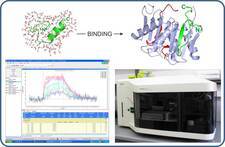SPR-based Characterization of Linear Motif Interactions
Formation and decomposition of protein complexes in the course of protein-protein interactions (PPI) can be followed in real time via a physical phenomenon, Surface Plasmon Resonance (SPR). SPR-based methods can determine the association and dissociation rate constants and thereby the strength of the interactions. XPR-36 is a state of the art SPR instrument that combines high precision with high throughput.
In the frame of this project we study the interactions of linear motifs and their binding proteins. Linear motifs are short peptide modules that - independently from the rest of the protein they resign in - bind to the surface of other proteins. Linear motifs participate in fundamental biological processes and are therefore associated to several serious diseases. Linear motifs are usually located at unstructured flexible parts of proteins. Traditional techniques are not well suited for linear motif interaction studies as these interactions are highly dynamic and transient. For this reason, it is likely that a large subset of such interactions have not even been identified yet. We study three protein families in the frame of this project. Two of them (LC8 and S100) are hub proteins.
In a previous study we combined directed protein evolution and bioinformatics to predict a large number of previously unidentified linear motif containing binding partners for the highly conserved LC8 dynein light chain (DYNLL). In this study we test the reliability of the predictions. We also aim to decipher how the sequence of a linear motif determines the kinetic and thermodynamic parameters of the interactions.
The vertebrate-specific S100A4 protein is associated to metastasis. This protein binds a linear motif on non-muscle myosin-2 isoforms with different efficiency. The SPR studies help us to reveal the causes of isoform specificity. Several additional S100-partner protein interactions - that we have already investigated by biochemical, cell biology and structural methods - are also studied in this project by SPR.
Mitogen-activated protein kinases (MAPK) are central players of intracellular signal transduction systems. MAPKs recognize their substrates and other protein partners through docking peptides. Docking peptides are linear motifs that bind to an ancient surface-exposed interaction site. Although human MAPKs participate in almost all physiologic processes only a few docking motif based binding partner is identified for these proteins. We will systematically characterize potential binding partners of MAPKs using the high-throughput SPR instrument. Only such a large scale approach can provide enough information for a system level analysis of the MAPK regulation network and for comparative evolutionary studies.

Gábor Pál - László Nyitray - Zsuzsanna Dosztányi - Attila Reményi
